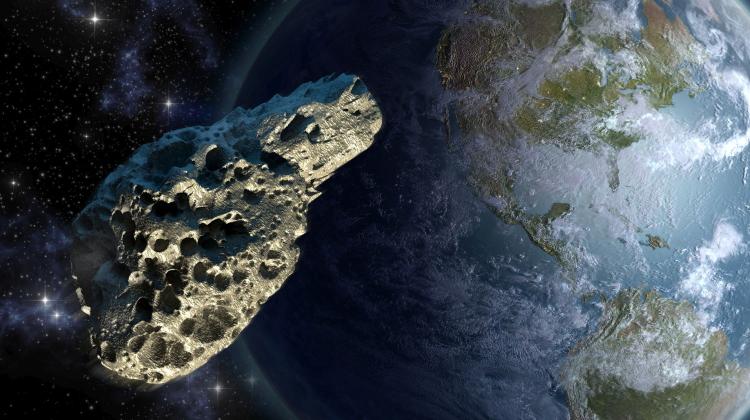Astronomy: We already know 700 thousand asteroids, there are less that can surprise us
 Photo: Fotolia
Photo: Fotolia
We know 700 thousand asteroids, including about 1.8 thousand objects known as "potentially dangerous to Earth". We know more about their orbits, and it is increasingly difficult to surprise us" - told PAP asteroid scientist Prof. Małgorzata Królikowska-Sołtan.
On September 1, 4 km in diameter asteroid (3122) Florence will pass the Earth at a distance of 7 million km (18 times the distance between our planet and the Moon). "We will not see from Earth with the naked eye, but we can look at it even through small telescopes" - told PAP Małgorzata Królikowska-Sołtan, professor of the Space Research Centre of the Polish Academy of Sciences in Warsaw.
Today we already know more than 700 thousand asteroids. Most of them are assigned only simple codes. Names are only given to more important objects - especially those, whose orbits are thoroughly studied (formerly Florence and her less grateful name, indicating the date of its discovery - 1981 ET3).
1800 THREATS
(3122) Florence is a asteroid "potentially dangerous to Earth." But it\'s not the only one. "We know as many as 1.8 thousand asteroids potentially dangerous to the Earth" - said the astronomer. Such objects are celestial bodies with a diameter of more than 140 m, which at some point will approach the Earth at a distance of less than 7.5 million km.
The professor from the Space Research Centre PAS noted, however, that there were no new grounds for concern, quite the contrary in fact. "We know more and more about asteroids, and there is less to surprise us" - she said. She added that there were at least a dozen scientific projects in the world - sky surveys that constantly analyse data and search for information about new asteroids. She explained that the already discovered asteroids were being monitored, and their orbits - more precisely determined.
WE ARE NOT DINOSAURS. THEY WILL NOT TAKE US BY SURPRISE
As described, if and asteroid as big as the one that contributed to the extinction of dinosaurs was approaching Earth, we would already known about it. "We already know about 95 percent of the asteroids in the Solar System that are more than 1 km in diameter, which can move closer to Earth. We can easily track them" - she said. And even if such a dangerous celestial body was not discovered, we would probably know about the danger a few years in advance. Asteroids close to Earth do not appear out of nowhere - just as the Earth, they orbit the Sun, so every now and then we "pass them by".
According to the researcher, scientists are increasingly able to predict the trajectories of large objects. For many years, in the simulations they have been taking into account not only the gravity of the Sun and the planets of the Solar System, they also analyse how the asteroid movements are affected by moons and other asteroids.
A BETTER IDEA THAN ARMAGEDON
Królikowska-Sołtan estimates that our technology would not allow to defend against the threatening asteroid just yet. "But in about 10-15 years it probably will" - she suspects.
At the suggestion to blow up an asteroid with explosives like in the movie "Armageddon", the professor smiled and commented that that this would probably not be the wisest solution. It would be too difficult to control the paths of the debris. Perhaps a better solution - according to the researcher - would be a controlled explosion near the asteroid. The force of the explosion would change the orbit of the object.
But scientists have other, less obvious ideas on how to change an asteroid trajectory. According to Prof. Królikowska-Sołtan, it is, for example, possible to try to change the way an asteroid reflects sunlight. So, for example, an asteroid could be... painted over. Increasing or decreasing the reflection of light affects how the object gets heated by the Sun. And the change in temperature affects both the speed of rotation and the object\'s movement. However, a rescue mission like that would have to be carried out dozens or even hundreds of years before the expected collision.
SMALL ASTEROID - HUGE CHALLENGE
The Earth, however, is not completely safe from cosmic encounters. Especially when it comes to smaller objects. "A few tons of dust a day enter our atmosphere from outer space" - noted Prof. Królikowska-Soltan. Small crumbs burn in the atmosphere and we do not even notice them. However, once in a few or a dozen years, the Earth is struck by a meteor with a diameter of a dozen or so meters - like in Chelyabinsk, Russia. "These objects usually fall into the ocean and no one even notices them" - said the researcher. She noted, however, that for now there is no way to predict when and where such small object - as on a cosmic scale - will fall.
PAP - Science and Scholarship in Poland, Ludwika Tomala
lt/ agt/ kap/
tr. RL
Przed dodaniem komentarza prosimy o zapoznanie z Regulaminem forum serwisu Nauka w Polsce.















